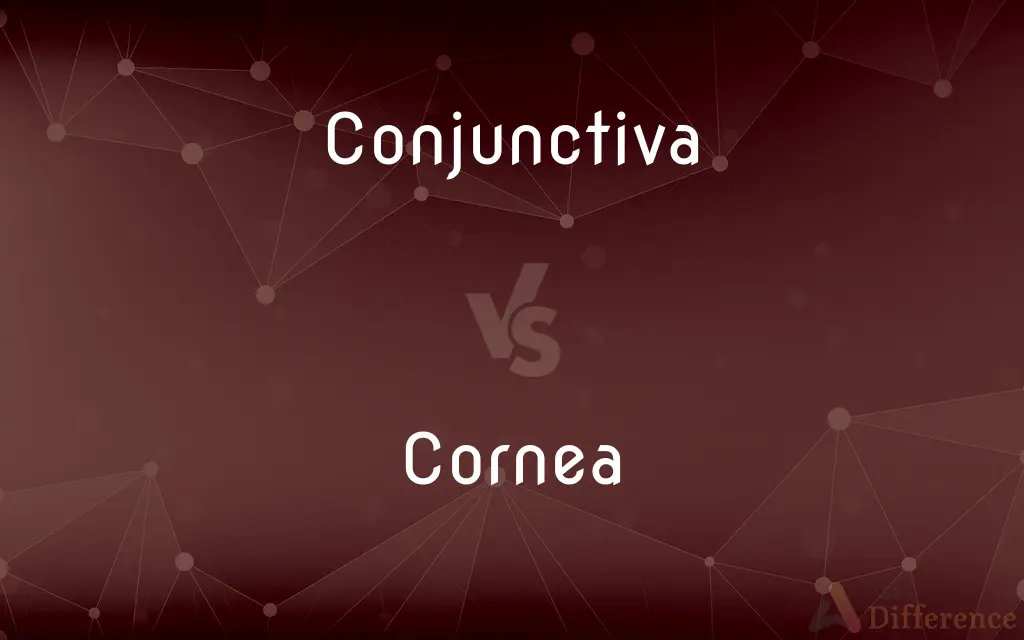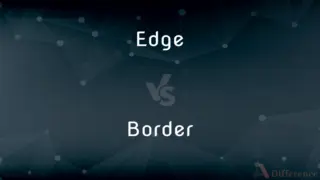Conjunctiva vs. Cornea — What's the Difference?
Edited by Tayyaba Rehman — By Maham Liaqat — Updated on April 23, 2024
The conjunctiva is a thin, clear membrane covering the white part of the eye and the inner eyelid, while the cornea is the transparent, dome-shaped front part of the eye that covers the iris and pupil.

Difference Between Conjunctiva and Cornea
Table of Contents
ADVERTISEMENT
Key Differences
The conjunctiva is a thin, flexible membrane that lines the inside of the eyelids and covers the sclera (white part of the eye), playing a crucial role in lubricating the eye by producing mucus and tears. In contrast, the cornea is a clear, dome-shaped surface that covers the front of the eye, including the iris and pupil, and acts as the eye's primary focusing element, bending incoming light to help focus it onto the retina.
While the conjunctiva serves to protect the eye from microbial and mechanical injuries by secreting mucus and tears, thereby keeping the eye moist, the cornea provides a barrier against dirt, germs, and other particles that might cause injury. The cornea also significantly contributes to the eye's total optical power, and its transparency is critical for vision.
The conjunctiva can become inflamed due to infections, allergies, or irritants — a condition known as conjunctivitis, commonly referred to as pink eye. This contrasts with corneal conditions like keratitis (inflammation of the cornea) or corneal ulcers, which often result from infections or wearing contact lenses improperly and can significantly affect vision due to the cornea’s role in light focus.
In terms of anatomical location and structure, the conjunctiva is more flexible and less structured than the cornea, which needs to maintain a precise curvature and thickness to focus light effectively. The cornea is also one of the most sensitive tissues of the body, densely packed with nerve fibers, more so than the conjunctiva.
From a medical treatment perspective, issues with the conjunctiva are often treated with eye drops or simple hygiene measures. In contrast, corneal issues might require more invasive treatments such as corrective lenses, surgery, or in severe cases, corneal transplants, reflecting the critical role of the cornea in vision compared to the primarily protective function of the conjunctiva.
ADVERTISEMENT
Comparison Chart
Function
Protects and lubricates the eye
Focuses light onto the retina
Location
Covers the sclera and inside of the eyelids
Covers the iris and pupil
Disorders
Conjunctivitis (pink eye)
Keratitis, corneal ulcers
Sensitivity
Less sensitive, mainly protective
Highly sensitive, critical for vision
Treatment
Eye drops, hygiene
Corrective lenses, surgery, transplants
Compare with Definitions
Conjunctiva
A membrane lining the eyelid and covering the white part of the eyeball.
The doctor said the redness in my eye was due to inflamed conjunctiva.
Cornea
Primary role in focusing light.
The cornea refracts light entering the eye, contributing to clear vision.
Conjunctiva
Prone to conjunctivitis.
The viral conjunctivitis made her conjunctiva swell and turn pink.
Cornea
Requires precise care in treatment.
Corneal diseases may require surgical interventions or transplants.
Conjunctiva
Vital for overall eye health.
Healthy conjunctiva contributes to overall eye comfort and health.
Cornea
The transparent front part of the eye that covers the iris and pupil.
His cornea was scratched by flying debris, affecting his vision.
Conjunctiva
Functions mainly in lubrication and protection.
Her conjunctiva keeps her eyes moist and free from dust.
Cornea
Susceptible to keratitis and ulcers.
Improper contact lens use caused her to develop corneal ulcers.
Conjunctiva
Easily accessible for treatment.
Conjunctiva treatments usually involve over-the-counter eye drops.
Cornea
Has a high density of nerve endings.
The cornea is one of the most sensitive parts of the eye, which is why corneal scratches are so painful.
Conjunctiva
The conjunctiva is a tissue that lines the inside of the eyelids and covers the sclera (the white of the eye). It is composed of non-keratinized, stratified squamous epithelium with goblet cells, stratified columnar epithelium and stratified cuboidal epithelium (depending on the zone).
Cornea
The cornea is the transparent front part of the eye that covers the iris, pupil, and anterior chamber. The cornea, with the anterior chamber and lens, refracts light, with the cornea accounting for approximately two-thirds of the eye's total optical power.
Conjunctiva
The mucous membrane that covers the front of the eye and lines the inside of the eyelids.
Cornea
The transparent convex anterior portion of the outer fibrous coat of the eyeball that covers the iris and the pupil and is continuous with the sclera.
Conjunctiva
The mucous membrane that lines the inner surface of the eyelid and the exposed surface of the eyeball.
Cornea
(anatomy) The transparent layer making up the outermost front part of the eye, covering the iris, pupil, and anterior chamber.
Conjunctiva
(anatomy) A clear mucous membrane that lines the inner surface of the eyelid and the exposed surface of the eyeball or sclera.
Bulbar conjunctiva
Cornea
The transparent part of the coat of the eyeball which covers the iris and pupil and admits light to the interior. See Eye.
Conjunctiva
The mucous membrane which covers the external surface of the ball of the eye and the inner surface of the lids; the conjunctival membrane.
Cornea
Transparent anterior portion of the outer covering of the eye; it covers the lens and iris and is continuous with the sclera
Conjunctiva
A transparent membrane covering the eyeball and under surface of the eyelid
Common Curiosities
Can corneal damage affect vision?
Yes, damage to the cornea can significantly affect vision since it is crucial for focusing light.
How are corneal issues treated?
Treatments can range from medication and corrective lenses to more severe measures such as corneal transplants.
What causes pink eye?
Pink eye, or conjunctivitis, is commonly caused by infections (viral or bacterial), allergies, or irritants affecting the conjunctiva.
What differentiates conjunctivitis from keratitis?
Conjunctivitis involves inflammation of the conjunctiva and is often less serious, whereas keratitis involves inflammation of the cornea and can severely impair vision.
What is the primary function of the conjunctiva?
The primary function of the conjunctiva is to protect and lubricate the eyeball and inner surfaces of the eyelids.
How does the cornea contribute to vision?
The cornea helps focus incoming light onto the retina, playing a critical role in vision clarity.
What are common symptoms of corneal and conjunctival issues?
Common symptoms include redness, pain, irritation, blurred vision, and discharge.
Is the cornea or conjunctiva more sensitive?
The cornea is more sensitive due to its high density of nerve endings, making it crucial for protective reflexes like blinking.
How are disorders of the conjunctiva and cornea diagnosed?
They are diagnosed through eye examinations, where symptoms and signs are assessed, sometimes using specialized equipment like slit lamps.
Can conjunctiva and cornea diseases be prevented?
Many conditions can be prevented with proper hygiene, use of protective eyewear, and appropriate care, especially when using contact lenses.
Share Your Discovery

Previous Comparison
Scoop vs. Scope
Next Comparison
Edge vs. BorderAuthor Spotlight
Written by
Maham LiaqatEdited by
Tayyaba RehmanTayyaba Rehman is a distinguished writer, currently serving as a primary contributor to askdifference.com. As a researcher in semantics and etymology, Tayyaba's passion for the complexity of languages and their distinctions has found a perfect home on the platform. Tayyaba delves into the intricacies of language, distinguishing between commonly confused words and phrases, thereby providing clarity for readers worldwide.
















































